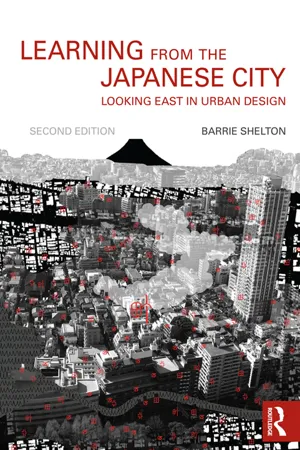
Learning from the Japanese City
Looking East in Urban Design
Barrie Shelton
- 192 pages
- English
- ePUB (mobile friendly)
- Available on iOS & Android
Learning from the Japanese City
Looking East in Urban Design
Barrie Shelton
About This Book
Japanese cities are amongst the most intriguing and confounding anywhere. Their structures, patterns of building and broader visual characteristics defy conventional urban design theories, and the book explores why this is so. Like its cities, Japan's written language is recognized as one of the most complicated, and the book is unique in revealing how the two are closely related. Set perceptively against a sweep of ideas drawn from history, geography, science, cultural and design theory, Learning from the Japanese City is a highly original exploration of contemporary urbanism that crosses disciplines, scales, time and space.
This is a thoroughly revised and much extended version of a book that drew extensive praise in its first edition. Most parts have stood the test of time and remain. A few are replaced or removed; about a hundred figures appear for the first time. Most important is an entirely new (sixth) section. This brings together many of the urban characteristics, otherwise encountered in fragments through the book, in one walkable district of what is arguably Japan's most convenient metropolis, Nagoya.
The interplay between culture, built form and cities remains at the heart of this highly readable book, while a change in subtitle to Looking East in Urban Design reflects increased emphasis on real places and design implications.
Frequently asked questions
Information
Table of contents
- Cover
- Half Title
- Title Page
- Copyright
- Contents
- Preface to the Second Edition
- Preface to the First Edition
- Second Edition Acknowledgements
- First Edition Acknowledgements
- Chapter 1. Western Interest in the Japanese City
- Chapter 2. Areas and Lines: From Written to City Texts
- Chapter 3. Aspects of Form: Street and Related Scenes
- Chapter 4. Strands of Culture
- Chapter 5. Learning from the Japanese City
- Chapter 6. Superblock Synthesis: ‘Glorious Gokiso’
- Appendix I. Japanese Historical Eras
- Appendix II. Glossary of Japanese Terms
- Bibliography
- Index